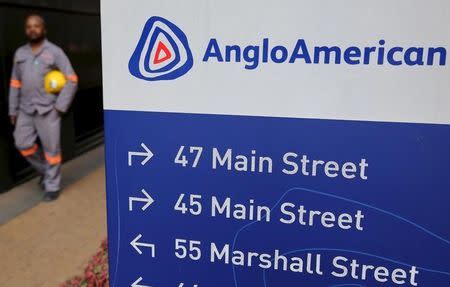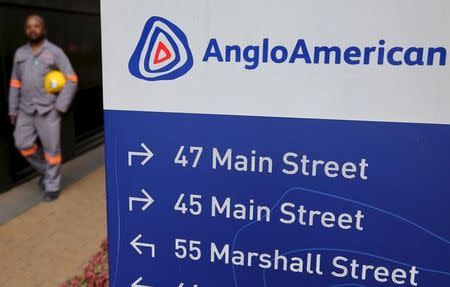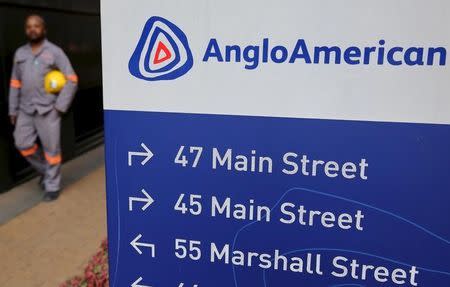Anglo American retreats as commodity slump bites
By Olivia Kumwenda-Mtambo
JOHANNESBURG (Reuters) - Anglo American aims to sell more assets, suspend dividends until the end of 2016 and whittle its business down to three divisions to cope with severe falls in commodity prices, the mining company said on Tuesday.
The overhaul at Anglo American highlights the scale of the fallout from the commodities slide, which is forcing mining companies across the board to cut jobs, investment and costs.
Anglo, the world's fifth-biggest global miner by market value, said it planned to offload three-fifths of its assets, reducing its workforce to just 50,000 from 135,000 now.
Anglo's shares, which had fallen 70 percent so far this year, slumped more than 12 percent to a record low after the overhaul was announced, with investors worrying that the new plan was only a short-term solution.
The London-listed company has suffered more than its rivals, largely due to higher-cost iron ore operations than at larger competitors BHP Billiton and Rio Tinto .
Anglo started paring back in 2013 but Chief Executive Officer Mark Cutifani said the company had to take "bolder action" to focus on assets that would deliver cash flow throughout the economic cycle.
The company will form three divisions: De Beers for diamonds, Industrial Metals for platinum and base metals, and Bulk Commodities for coal and iron ore.
It aims to raise $4 billion (£2.7 billion) through assets sales, up from an earlier target of $3 billion, and said it would press ahead with the sale of its phosphates and niobium businesses in 2016.
"You could maybe get even over a billion for those, they’ve got higher multiples - but the question is what do you actually get paid for it today," a banker for the mining sector said.
Anglo, which also plans to sell some coal assets in Australia and South Africa and close mines losing money, said it had secured $2 billion from asset sales so far.
"SURVIVAL PLAN"
Anglo plans to focus mainly on its diamond, platinum and copper businesses as they offer better long-term potential, Cutifani told investors at a presentation in London.
"Assets in nickel, coal and iron ore will have to compete and demonstrate their ability to drive down the cost curve, with the ability to deliver cash through the cycle. If not, they won't be in the portfolio, it's as simple as that," he said.
Spot iron ore fell to a decade low below $40 a tonne on Tuesday and futures prices suggested more weakness for the steelmaking commodity already down by nearly half this year.
To keep up with low prices, Kumba Iron Ore , a division of Anglo, said it would reconfigure its main Sishen mine. It will target costs of $30 per tonne and a breakeven price of $40 a tonne in 2016.
Anglo also said it expected its Minas Rio iron ore mine in Brazil to reach full capacity of 26.5 million tonnes in 2018, later than the second quarter of 2016 as previously announced.
Cutifani said Anglo would give more details on its future portfolio in February alongside its annual results. The company said its forecast for net debt for the end of 2015 was unchanged at $13 billion-$13.5 billion.
"With net debt still high relative to the current market cap, this looks like a survival plan for the next two years," SP Angel analysts said in a note.
Anglo indicated that when it reinstates dividends they will rise and fall in line with earnings, abandoning a policy under which its payout rises, or is at least maintained.
The miner also lowered its capital spending plans to $3.2 billion in 2016, down from an earlier forecast of $3.6-$3.9 billion, and $2.5 billion in 2017.
The company also said it expected to take charges of $3.7 billion to $4.7 billion due to weaker prices and asset closures.
(Additional reporting by Freya Berry in London; editing by Susan Fenton and David Clarke)





